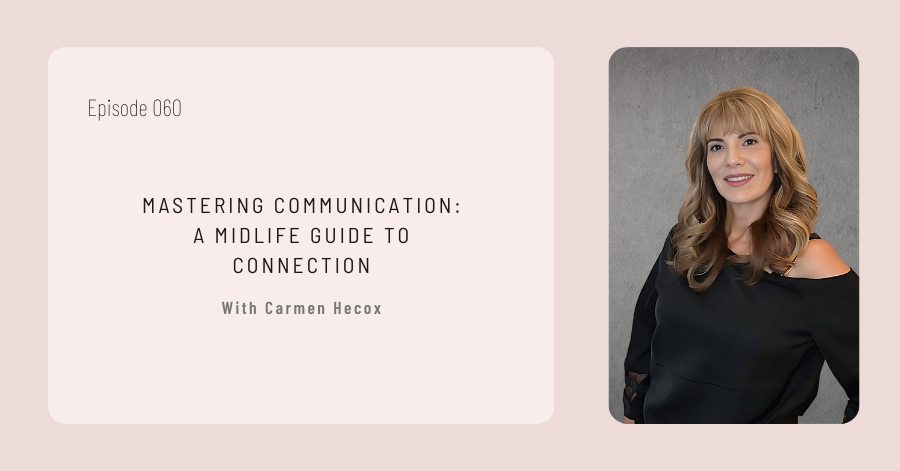Mastering Communications: A Midlife Guide to Connection
Discover How Effective Communication Transforms Relationships and Fosters Deeper Connections
Revealing the Power of Communication: Your Key to Thriving in Midlife
Are You Ready to Transform Your Most Important Relationships?
Step into a world where every conversation with loved ones evolves from just chatter into powerful, heart-to-heart connections. In this exploration, uncover how fine-tuning your communication skills during midlife isn't just beneficial—it's essential. Harness these skills to navigate life's changes with grace and strengthen bonds with those you hold dear. Dive deep into the art of mastering communications and discover how to turn every dialogue into an opportunity for growth and deeper understanding. Ready to change how you connect with the world around you? Let's embark on this transformative journey together.
The Vital Role of Mastering Communications in Midlife
Why does mastering communication become increasingly crucial as we journey through midlife? This stage of life is marked not only by personal growth but also by significant transitions in almost every aspect of existence—career changes, shifts in family dynamics, and the deepening of relationships. It's a time when many find themselves reassessing priorities and values, making it the perfect moment to refine our interaction skills.
Effective communication during midlife acts as a pivotal tool for navigating these changes. It enables us to articulate our evolving needs and desires clearly and compassionately, ensuring that we are understood by those around us. It also plays a crucial role in maintaining and strengthening our most cherished relationships. By mastering this skill, we empower ourselves to handle conflicts with grace, express our thoughts with confidence, and listen deeply to others’ perspectives, facilitating a richer, more connected life.

Navigating Communication Styles for Harmony
Understanding the Four Styles
At the core of our exploration are the four main communication styles: passive, aggressive, passive-aggressive, and assertive. Recognizing which style we default to and understanding how each impacts our interactions is the first step toward developing a more adaptable and effective communication approach.
- Passive communicators often avoid expressing their own opinions or needs, prioritizing others’ preferences to avoid conflict.
- Aggressive communicators tend to dominate conversations, sometimes at the expense of others' feelings, using their assertiveness in a way that can be perceived as hostile.
- Passive-aggressive communicators express dissatisfaction indirectly, confusing and frustrating conversational partners and obscuring real issues.
- Assertive communication, however, strikes a balance, advocating for one's own needs while considering and respecting the needs of others.
Assertive Communication: The Gold Standard
Assertive communication is indeed the gold standard when it comes to styles, especially in midlife. This style enables individuals to express their thoughts and feelings confidently and openly without infringing on the rights and beliefs of others. It’s about being honest and direct while also being respectful and receptive to others' feedback.
Adopting assertive communication helps in building respect and trust among peers, friends, and family members. It fosters a positive atmosphere where all parties feel heard and valued, paving the way for more meaningful and satisfying relationships. This style not only helps in clearly stating one's needs and making decisions collaboratively but also in setting boundaries, a critical aspect of interactions as one navigates midlife changes.
By mastering assertive communication, individuals enhance their ability to manage both personal and professional relationships more effectively, making it a cornerstone of successful interactions as we age.

Empowering Strategies for Effective Communication
In midlife, communication becomes more than just exchanging information; it evolves into an art of conveying thoughts and emotions that can significantly enhance relationships. To harness this power effectively, several strategic approaches can be employed. These strategies not only improve how we express ourselves but also deepen our understanding of others, fostering a richer dialogue and stronger connections.
Crafting “I” Statements
One of the most powerful tools in the communication toolkit is the use of “I” statements. This approach shifts the focus from blaming or criticizing others to expressing one’s own feelings and needs. By framing thoughts around “I” instead of “you,” conversations become less confrontational and more about personal feelings and perceptions.
For example, instead of saying, “You never listen to me,” an “I” statement would be, “I feel unheard when I talk about my day, and you seem distracted.” This not only opens up the space for less defensive responses but also promotes a clearer understanding of personal impact without assigning blame.
Mastering Active Listening
Active listening is another cornerstone of effective communication, especially crucial as we navigate the complex emotional landscapes of midlife. It involves fully focusing on the speaker, understanding their message, responding thoughtfully, and remembering the conversation. It’s not merely about hearing words but engaging with the entire message, both verbal and nonverbal.
To master active listening, one must:
- Give full attention to the speaker: This means putting aside distracting thoughts and behaviors, making eye contact, and not interrupting while they are speaking.
- Show that you are listening: Use body language and gestures to convey attention, such as nodding, smiling, and maintaining an open posture.
- Provide feedback: Reflect on what has been said by paraphrasing. For example, “What I'm hearing is that you feel overwhelmed by work,” can reassure the speaker that their message is being understood.
- Defer judgment: Active listening requires withholding judgment until the speaker has finished conveying their thoughts.
- Respond appropriately: Active listening is completed by an honest, respectful response. It’s about encouraging open communication and expressing oneself assertively in return.
By integrating these strategies into daily interactions, communication becomes not just a tool but a bridge to greater empathy, clearer understanding, and more resilient relationships. These strategies are especially effective in midlife, a time when many are seeking deeper connections and more meaningful exchanges in both personal and professional realms.
Join our community
Connect with like-minded individuals.

Real-Life Applications of Communication Skills
Transitioning from understanding communication concepts to applying them in everyday interactions is where the real transformation occurs. It's one thing to know about effective communication strategies; it's another to put them into action in the scenarios that matter most. This section explores how to apply these skills in real-life settings, providing practical examples that demonstrate the profound impact of effective communication on personal relationships, especially during midlife.
From Theory to Practice
Applying communication skills effectively involves more than just understanding different styles or techniques; it requires practice and intentionality in daily interactions. For example, consider a common scenario in midlife: navigating a significant life change such as a career transition, health issues, or children leaving home. These situations can strain relationships unless handled with thoughtful communication.
Using “I” statements in these situations helps express personal feelings without casting blame. For instance, during a career change, rather than expressing frustration obscurely or indirectly, one might say, “I feel anxious about my job situation and need your support to talk through my options.” This opens the door to supportive dialogue, easing the stress and fostering understanding.
Rekindling Connections
One of the most cherished applications of refined communication skills in midlife is rekindling connections with partners, friends, or family members. As relationships mature, the novelty of earlier years may diminish, making active listening and empathetic engagement more crucial than ever.
Consider a scenario where a couple feels the strain of routine and familiarity dimming their connection. Instead of resigning to silence during dinner, one might use active listening to engage their partner. Asking open-ended questions about their day or feelings and truly listening to the responses can rekindle intimacy. For instance, saying, “I'd love to hear more about what you're working on; it sounds like it's important to you,” shows genuine interest and appreciation for their experiences.
By prioritizing these strategies—actively listening, empathizing, and expressing oneself clearly—individuals can revitalize relationships that might otherwise grow stagnant. These approaches not only mend gaps but also build a stronger, more resilient foundation for future interactions, ensuring that midlife becomes a period of growth and deepening bonds rather than one of isolation or misunderstanding.

Reflections on the Journey of Communication Mastery
As we navigate the journey toward mastering communication, it's essential to reflect on the profound changes that these skills can bring to our lives, especially in midlife. This stage of life offers a unique opportunity to leverage our accumulated wisdom and experiences, applying them through refined communication to enhance every interaction. Mastering the art of communication not only improves relationships but also enriches the individual’s sense of self and connection to others.
Understanding and applying different communication styles, actively listening, and effectively expressing oneself can transform potential conflicts into opportunities for deeper understanding and connection. The ability to communicate assertively, for instance, does not merely avoid misunderstandings; it fosters an environment where all parties feel valued and heard, significantly boosting the quality of interactions and relationships.
Reflecting on these skills allows us to appreciate the growth in our personal and professional lives. Communication mastery is a continuous journey, one that requires practice, commitment, and a willingness to adapt and learn. Each conversation is an opportunity to practice these skills, making each interaction more meaningful and fulfilling.
Closing Thoughts and Call to Action
Thank you for joining this exploration of effective communication. The journey doesn’t stop here; it's an ongoing process of growth and improvement. If you’ve found value in today’s discussion and wish to enhance your relationships and daily interactions, consider further engaging with these concepts. Share this exploration with someone who might benefit from it and continue to apply these strategies in your own life.
For those eager to dive deeper and continue this journey, consider subscribing here, on YouTube, or on the podcast. Your engagement helps us produce more insightful content like this, providing tools and knowledge to better navigate the complexities of communication and relationships.
Until next time, keep practicing, listening, and striving for deeper connections. Remember, every conversation is an opportunity to create a more understanding and compassionate world. Keep communicating, keep connecting, and let’s continue this journey together.
Watch the complete episode here.

Resources Mentioned:
Subscribe to Apple Podcasts, and don't forget to Rate and Review
Like what you heard? If so, please rate and comment on Apple Podcasts. And while you are there, let me know what you want to hear next.
And while you are there, don't forget to hit Subscribe.


